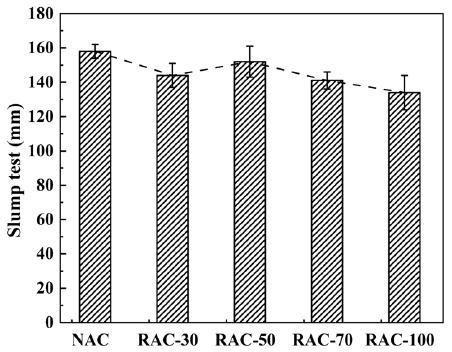
26 minute read
The effect of freeze-thaw on the performance of recycled concrete pavement
Shoddo Elias Haile, Yuanzhen Liu*
CollegeofCivilEngineering,TaiyuanUniversityofTechnology,Taiyuan030024,China
Advertisement
Received: 18 Dec 2022,
Receive in revised form:19 Jan 2023,
Accepted: 25 Jan 2023,
Available online: 06 Feb 2023
©2023 The Author(s). Published by AI
Publication. This is an open access article under the CC BY license (https://creativecommons.org/licenses/by/4.0/).
Keywords Recycled aggregate concrete, Freeze-thaw cycle, Flexural strength, Surface deterioration Recycled concrete pavement
Abstract Freeze-thaw damage is one of the most serious issues that can affect pavement made of recycled concrete in cold places. The recycled concrete pavement freeze-thaw deterioration mechanism still needs to be fully understood. In this study, a number of different experimental investigations were conducted. on several concrete specimens that contained differing percentages of RCA replacements by volume (0%, 30%, 50%, 70%, and 100%, respectively). Several freeze-thaw cycles have been exposed to the concrete specimens. In order to assess the performance of the casted specimens, the mass loss, relative dynamic modulus of elasticity (RDME), and length change were estimated. The results demonstrate that the incorporation of recycled coarse aggregate significantly affects the performance of the specimens. Flexural strength tests have been used to evaluate the degree to which the specimens' mechanical properties have deteriorated. After being subjected to several freeze-thaw cycles. For all mixtures, the 28-day flexural strength values were calculated. The test result shows the flexural strength value of the specimens was inversely proportional to the replacement of RA. The flexural strengths of the specimens dropped as the number of RA increased. Furthermore, the specimens with more RA replacement have a greater drop in flexural strengths. Moreover, an analysis of the freezethaw cycle's process and its damage mechanism was revealed.
I. INTRODUCTION
In the development of the construction industry. There is an excessive utilization of natural resources, which leads to overconsumption. In order to satisfy this demand, a huge quantity of aggregates needed to be manufactured, resulting in the deterioration of the environment. Because natural aggregatesare inshort supply incertainregionsoftheworld, an urgent need to develop aggregate made from recycled materials as a replacement source. Due to the fact that recycled aggregates made from construction and demolition debris have the capability of being used in eco-friendly concrete structures, there has been an increase in interest in the possibility of using these aggregates. [1] In the last few decades, recycled aggregate has been widely used in different pavement structures, such as highway pavement [2–4], asphalt pavement [5–7], and concrete pavement [8–10]. However, Recycled aggregate is usually utilized as a partial substitute for coarse aggregate in various pavement structures. Due to its weaker ability to withstand a cold environment. In accordancewiththeinvestigationsofseveralresearchers,the recycled pavement has less freeze-thaw resistance.
Concrete pavements have the advantage of being more resistant to frost damage than asphalt pavement. However, at low temperatures, recycled concrete pavement gains very little strength due to the special unique characteristics of recycled concrete aggregate. As a result, the pavement deteriorates while being used in cold environments. Pavements in cold regionshave a high tendency tobe severe damage by freeze-thaw because of the wide-open surfaces. This phenomenon can cause the expansion of water in the pavement structure. When water begins to freeze inside the concrete capillary pore, there are two significant effects on the concrete structure. One of two effects the first expanding the cavity by 9% and the second driving the additional water out via the specimen's boundaries or both combined can occur [11] Hydraulic pressure is produced during this process, and the amount of this pressure is dependent on the distance to an "escape boundary," the permeability of the intervening material, and the rate at which ice is formed. Practical experience has revealed that disruptive pressures will develop in a saturated concrete paste except each capillary cavity in the paste is within a certain distance of the nearest escape boundary [12] Cracking and spalling of concrete specimens are produced as a direct result of this phenomenon which causes the matrix of cement paste to expand as a result of freezing and thawing [13] The performance of concrete is not only dependent on the mechanical properties of the concrete but also has a significant influence on the durability properties of concrete. Durability under freezing and thawing conditions is one of the primary concerns related with RCA applications in cold regions [14]. The freezing and thawing damage to concrete pavement occurs when free water in the pore’s freezes, causing phase transition forces in the pore structure that are similar to cyclic loads. Osmotic pressure causes the cement paste matrix to frost as a result of numerous cycles of freezing and thawing., which causes the formation of porosity and microcracks. When these phenomena occur, cracks and spalls appear in the concrete, which eventually damages its internal structure [15] Freeze-thaw cycles can deteriorate the performance of concrete andexacerbatedurability problems severely. Some scholars believe that, Because RCA has such a high permeability, its pore structure is incapable of becoming saturated with water; In most cases, the recycled pavement would not sustain damage from the cycle of freezing and thawing. However, several practical cases reveal that the high porosity of RCA is more susceptible to deterioration from freeze-thaw cycles [16] Indeed, a significant number of study has been conducted on the RACs durability when exposed freezing-thawing [14–20]. Relatively, limited studies were conducted associated with the damage of freezing and thawing cycle on recycled concrete pavement. Therefore, the effect of the repeated freezing and thawing cycle upon the performance of recycled pavement needs to be methodically and scientifically studied in order to guarantee the pavement's engineering quality in cold environment The influence of the freezing and thawing cycle in concrete pavement made with recycled aggregate is a complex process that can remarkably affect strength of pavement[21-22], and stiffness [26]. Due to the possibility of structural damage to the pavement, when assessing the performanceofpavements Freeze-thaw cycle is theprocess that needs to be taken into consideration. The freezingthawing process has an effect on the engineering behavior oftherecycled concretepavementinwhichspecialattention has to give to its flexural strength [27] According to the Federal Highway Administration, RCA has lower density, higher water absorption, higher permeability, and more soundness mass loss compared to natural aggregates [28] Investigating the properties of RCA reveals advantages for constructing a high-quality road for various weather conditions.
The main purpose of this study presented in this work is to analyze the freeze-thaw effect on recycled concrete pavement. The investigation consists of three different phases. The primary phase investigates the properties of concrete mixes produced with NAC and RAC for pavement application. A numberof concrete specimens were cast with various RA replacements in the laboratory. In the second phase, the specimen’s performance has been evaluated using mass loss, relative dynamic modulus of elasticity (RDME), and length change. The degradation on mechanical properties of specimens after exposed to freezethaw environments has been assessed using a flexural strength test. Furthermore, the effects of the RAC replacement ratio (0%, 30%, 50%, 70%, and 100%) and the number of freeze-thaw cycles has been investigated. Moreover, an analysis of the freeze-thaw cycle's process and its damage mechanism was revealed.
II. MATERIALS AND EXPERIMENTAL METHODS
2.1. Materials
In this study, the concrete mixtures contained Ordinary Portland cement, silica fume, sand, tap water, and a waterreducing admixture called Poly-carboxylate superplasticizer. Therecycled coarse aggregates used inthis concrete mix were made from crushed concrete debris, which was commercially purchased from Beijing, China. With aggregate sizes ranging from 5.0 to 20.0 mm in diameter, the natural coarse aggregates produced from crushed limestone the same diameter as the recycled coarse aggregate. A local river sand with a fineness modulus of 2.5 was used as the fine aggregate. The ordinary Portland cement used in this experiment has a fineness modulus of 0.63 and a 28-day compressive strength of 42.5 MPa. An average particle size of 180 nm has been measured for silica fume. Furthermore, in order to reduce the quantity of water required for concrete production by 35-40%. A polycarboxylate superplasticizer was added in the concrete mixture. In Table 1, the material properties and constituents of silica fume and ordinary Portland cement are listed.
A number of experimental tests of different aggregates have been conducted for both natural coarse aggregate (NCA) and recycled coarse aggregate (RCA). In accordance with the Chinese Standards GB/T 25177 and JCJ53 [26-27] Additionally, to compare the results of this study with those of previous investigations, the shape index was measured according to the European standard EN933-4 [31]. The physical properties of NAC, RAC, and NFA are summarized in
2.2. Preparation of specimens
All mixtures were prepared and cured in the State Key Laboratory of Concrete Properties at Taiyuan University of Technology in accordance with [32]. The cement, silica fume, coarse aggregate, and sand were added to dry-mixed for about two minutes before water and superplasticizer were added. Since the water absorption is too high, the recycled aggregates were first washed and presoaked until they reached the saturate-surface-dry condition (SSD). For the purpose of maintaining the fresh concrete slump standard, the workability of the mixture was determined using a slump test after three minutes of mixing with water. The mixture in each group was cast in 100 mm×100 mm ×400 mm and 100 mm×100 mm ×100 plastic molds, then compacted on the vibration table. The specimens were preserved in a room-temperature environment for a period of twenty-four hours after casting, then demolded and cured in water at 20 ± 2 °C and humidity of 90% for 28 days in a standard curing room, then the tests were carried out. The specimen's compressive strength was measured using cube specimens,whiletheflexuralstrengthwasdeterminedusing prism specimens.
2.3. Specimen numbering
All specimens got a special name consisting of a letter and digits. The letter before the number represents the replacement of recycled coarse aggregate to natural coarse aggregate.Thenumberaftertheletterrepresentsthenumber of freeze-thaw cycles, and the letter represents the type of aggregates. RA for RCAs, and NA for NCAs specimens. RA + replacement percentage + freeze-thaw, where NA or RA represents the type of aggregate used The basic information about the specimens is summarized in Table 3.
Table 3 Mix proportions of concrete (kg/m3).
Note: fc (MPa), Compressive strength (28days)
III. TEST METHODS AND PROGRAM
3.1. Workability test
Theworkabilitytestwasconducted inaccordancewith [33] Three minutes after mixing, several samples were randomly taken from different mixtures and then examined for the slump test. The relationship between the aggregate replacement ratio and slump values of the concrete specimens is shown in Fig. 1. It is commonly believed that aggregates with spherical shape and lower water absorption capacity would significantly enhance the concrete workability. However, by increasing replacement of recycled aggregate by the natural aggregate, the slump of concrete specimens decreases sequentially because RCA has a great capacity for absorbing water. The rough surface of recycled coarse aggregate absorbs part of the water required for actual mixing, which would be the reason for the reduction of concrete slump.
ranged from -16 ± 2 °C and 8 ± 2 °C. The temperature fluctuations that were observed during one of the cycles are shown in Fig. 2. The number of freeze-thaw cycles was set at 50, and after each phase, the specimens were carefully removed from the chamber to dry before moving on to the following experiment. The freezing and thawing apparatus used in this study is shown in Fig 3
3.2. Freeze-Thaw cycle test
The freeze-thaw tests were conducted using an automatic freezing and thawing apparatus. Before the freeze-thaw test, the specimens were soaked in tap water for 72 hours at a temperature of 20 ± 2 °C. The level of the water was about 20-30 millimeters over the specimens' top surface. The specimens were placed in the freeze-thaw chamber in accordance with [34]. The plastic specimen tanks were filled with tap water, and the liquid level was kept 5-10 mm above the specimen's top surface during the test process. the cover of the freeze-thaw box was then put back in place. Inside the freeze-thaw chamber, there are four temperature sensors. One of them measures the inner temperature of the specimens, while the other three measure the temperature of the cool box, with temperature ranging from -20 ± 2 °C to +20 ± 2 °C for a single freeze-thaw cycle that lasted for about 3 ±0 .1 hours. However, there was an exception for some specimens, in which the temperature of inner concrete
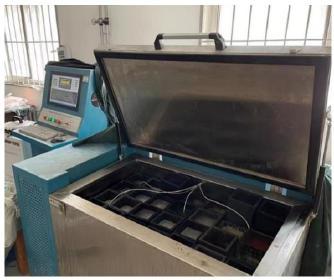
3.3 Mass loss, Relative dynamic modulus of elasticity (RDME), and Length change
The effect of freeze-thaw on the performance of concrete made with recycled aggregate was determined in reference to mass loss, relative dynamic modulus of elasticity (RDME), and length change. During this stage, a nondestructive test was conducted for every specimen with an interval of50 cycles offreezing andthawing Before the test begins, the specimens were carefully removed from the freezing and thawing chamber and placed on a dry surface to reduce the possibility of any artificial damage. The specimens were also visually inspected for surface scaling at the same time. The test was carried out sequentially on each specimen, and the average value of each specimen was used to determine the final result. A summary of the test method and procedures used to evaluate the performance of recycled concrete during freeze-thaw is presents
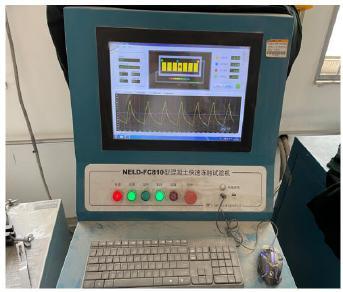
4 Test equation and method
3.4. Flexural strength test
The prismatic specimens were put through the flexural strength test according to [35] by using the microcomputercontrolled electro-hydraulic universal testing machine as illustrates in Fig 4 After curing the specimens for 28 days, the tests were performed. The specimens were removed from the freeze-thaw chamber and subjected to a flexural strength test at the beginning of every 50 cycles. Each specimen's load-deflection curve was automatically recorded by the computer, and the final result was calculated by averaging the data from all of the specimens.
IV. RESULTS AND DISCUSSION
4.1. Surface deterioration
The first 50 freeze-thaw cycles for both NCAs and RCAs specimens, as shown in Fig. 5. There was no significant appearance change that had been shown on the surface of the specimens. After 50 freeze-thaw cycles, mortar scaling was observed in every specimen. Furthermore, in the RAC100 specimens, both mortar scaling and edge spalling were observed at the same time, exposing it to the risk of damage. This is proof that the amount of freeze-thaw cycles and the percentage of RA replacement speed up the degradation of concrete [21] Moreover, after 100 freezethaw cycles, edge-spalling was clearly observed in RAC-30 and RAC-50 specimens, but the corner of the specimen was not spilled yet. However, only a small fraction of mortar was scaled among the NAC specimens. Besides, RAC-70 and RAC-100 specimens experienced more severe damage due to higher aggregate mass loss. As shown in Fig. 5 when the freeze-thaw cycle exceeded 150, deformation began to accelerate quickly. For the remaining RAC specimen. On the surface of the concrete, there was a significant amount of mortar that had spilled. For instance, the broken-down of coarseaggregatesinthecornersoftheRAC specimenswere common. This is due to the fact that recycled coarse aggregatehasmanyimpuritiesandweakITZs,whichwould result in greater damage to the specimen [36]. Nevertheless, the concrete with NA was just slightly spilled.
Numerous researchers agree that concrete made with NA hashigherfrostresistancethan concretemadewithRA.Due to many factors, such as the presence of old attached mortar [17], high porosity [37], high water absorption [38], high creep and shrinkage [39], and low hydrostatic pressure resistance [20] Nevertheless, after 250 freeze-thaw cycles, nearly all of the mortar on the concrete with the NA specimen had spalled, and the freeze-thaw test was terminated.
4.2. Mass Loss
The mass loss is the direct signal of the degree of deterioration to the concrete specimen caused by repeated cycles of freezing and thawing. In this paper, the mass loss was measured every 50 freeze-thaw cycles. At the beginning of the freeze-thaw cycle, the mass of both RAC and NAC specimens increases and then decreases. This is because of the existence of initial damage inside the concrete, which absorbs part of the water and makes the specimen too dense. In this stage, the mass of the absorbed water is greater than spalling mortar. Moreover, when there is an increase in the number of freezing and thawing cycles, the mass of both RCA and NCA drops down. The hydraulic [40] and osmotic [41] pressure is the reason for the specimens to disintegrate, which leads to resulting in a reduction of mass. Nevertheless, the mass loss of RCA was much faster than NCA. This is primarily because RAC has more pores: at the same time, the attached old mortar on the surface of the RCAs became a weak link with the accumulation of freeze-thaw damage [42].
The mass loss curve of RAC-30 and RAC-50 during the initial phase of the freeze-thaw was similar to that of NAC, as presented in Fig.6. The loss rate of RAC-70 and RAC100 is gradually higher than that of NAC. When there is an increase in the number of freezing and thawing cycles., although the loss trend of RAC-30 and RAC-50 is roughly equal. It is clear that the replacement percentage of recycled coarse aggregate significantly affects the mass loss rate of the specimen, indicating that the replacement rate regulates the specimen’s frost resistance. The number of freezing and thawing cycles might range anywhere between 50 and 250, the mass loss curves for RAC-30 and RAC-50 were less than 2%. However, in contrast to NAC, the mass loss curve for the RAC-70 and RAC-100 specimens rises steeply throughout the same freeze-thaw cycles.
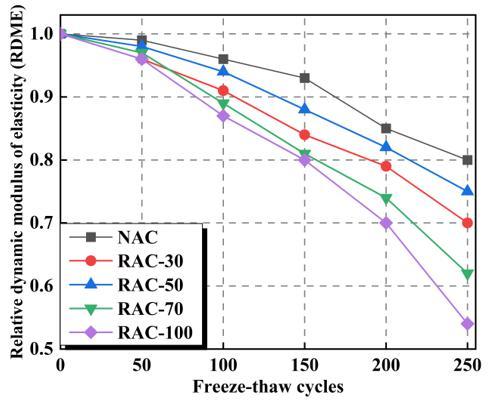
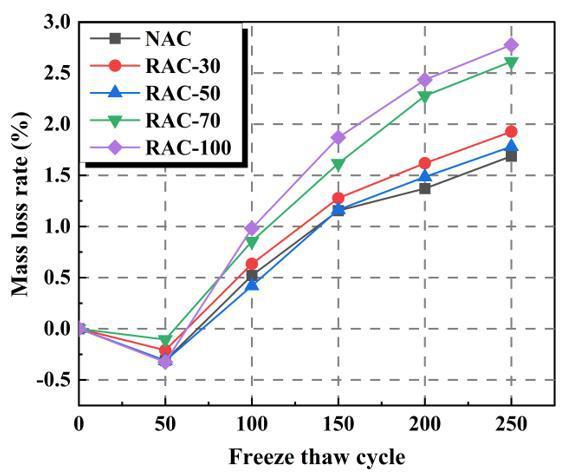
4.3. Relative Dynamic Modulus of Elasticity (RDME).
The change in the relative dynamic modulus of elasticity for both NAC and RAC specimens after being exposed to several freeze-thaw cycles is presented in Fig. 7. At the beginning of freeze-thaw cycles, the relative dynamic modulusofelasticityforbothNACandRACdecreaseswith the increase of freeze-thaw cycles. However, after 100 freeze-thaw cycles, the decline speed of RAC-70 and RAC-
100 was significantly greater than that of NAC, which indicates that the replacement of recycled aggregate not only reduces the frost resistance of concrete but also accelerates the internal expansion of the concrete specimens. In contrast, the relative dynamic modulus of elasticity reduction for RAC-30 and RAC-50 was roughly similar. In addition to this, the relative dynamic modulus of the elasticity of RAC-100 dropped below 60% after 250 freezethaw cycles as compared to the value it had at the beginning of the freeze-thaw cycles. As a result, the findings demonstrate that usage of recycled aggregate in place of natural aggregate has significant reduction on the stiffness of the recycled concrete specimens.
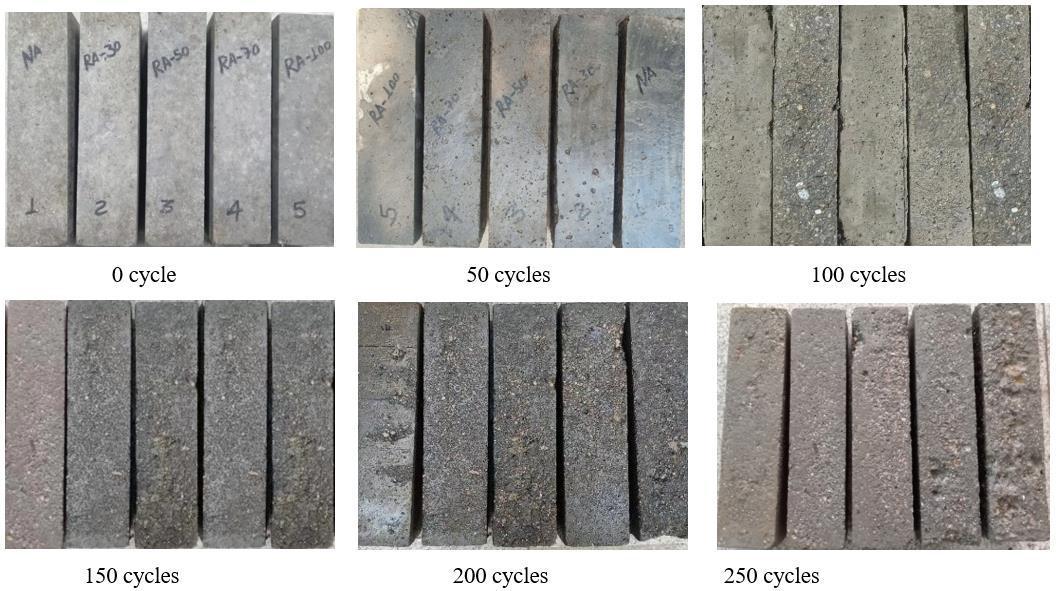
4.4. Length change
The length change values of both RAC and NAC specimens after being exposed to several freeze-thaw cycles are illustrates in Fig. 8 All specimens' lengths are shown to remain constant at 50 freeze-thaw cycles. When the specimens reached 100 freeze-thaw cycles, there was a visible length change gap between the NAC and RAC specimens. This phenomenon occurred due to the edges of the RAC specimens were crumbled and then spilled, which shortened the length of the RAC specimens.
The length change curves for NAC and RAC-30 specimens were nearly similar until the specimens reached 200 freezethaw cycles: on the other hand, the RAC-70 and RAC-100 curves were very steep after 150 freeze-thaw cycles. This is due to the RAC specimens having low forest resistance, which causes the specimens to disintegrate. When the freeze-thaw reached 250 cycles, the length change values were in decreasing order of RAC100 > RAC70 > RAC30 > RAC50 > RAC0.

4.5. Flexural strength test
The maximum load value at which the concrete specimens in the test were able to fracture was determined by the testing machine. The flexural strength of the specimens was determined using the following formula.
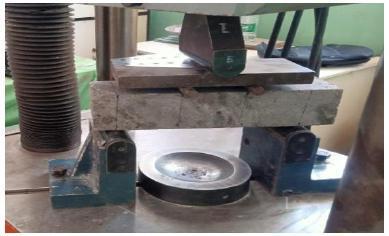
R= ���� ����2
Where: R is the rupture modulus. F maximum applied load indicated by the testing machine, b, h is respectively crosssection of the average width and the average height of the specimen, and l is the span length of the specimen. In this test, b=100mm, h=100mm, and l=300mm.
Based on the maximum load value of each specimen, the value of the flexural strengths was calculated using Eq 1. It should be noted that all beam fractures took place in the middle third of the span length during the test. For each RA replacement, the average flexural strength result of the specimen after being exposed to various cycles of freezethaw is shown in
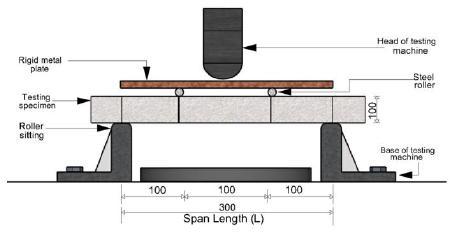
During the experimental test, the value of flexural strength of the concrete specimens were inversely proportional to RA replacement. As the number of RA increased, the flexural strengths of the specimens decreased. Furthermore, the specimens with more RA replacement have a greater drop in flexural strengths. In decreasing sequence of RAC100 > RAC70 > RAC30 > RAC50 > RAC0.
In general, every freeze-thaw cycle causes recycled concrete's flexural strength to rise and decline for example, in 50 freeze-thaw cycles, the flexural strength value decreased by 4.09, then increased by 4.33, and then again decreased by 3.99. This fluctuation happened because of the improper amount of recycled aggregate replacement towards its optimal value [42-40] determined that the recycled aggregate replacement percentage has an "optimal value."Theflexuralstrengthofconcretewilldecreaseeither when the replacement rate is lower than the optimal value or when it is higher than the optimal value. According to this test results, RAC-50% had the lowest amount of flexural strength loss and had higher flexural strength than the other recycled concrete specimens that had been exposed to freezing-thawing cycles. Thus, we can conclude that "optimal value" of the replacement rate for this test is RAC-50%.
In comparison to the other specimens, RAC-100's flexural strength loss was much greater, especially when repeated cycles of freezing and thawing cycles rose. For 0 freezethaw cycles, RAC 0%, 30%, 50%, and 70% similarly showed an increase in flexural loss between 1.39% and 8.37%. However, in RAC-100, the flexural loss drops by 11.0078%. This is an indication that the replacement of RAC not only affects the mechanical properties of the specimens but also gets significantly affects their durability properties [14] Because of this reason, special consideration must be given to the flexural strength of recycled concrete aggregate [27]
The flexural strength loss curve of different aggregate replacements after being exposed to different freeze-thaw cycles was also studied, with results shown in Fig 9 in various proportions. Several studies conclude that when the RA specimen experienced several freeze-thaw cycles, its flexural strength decreased [44-42] In accordance with the results of this investigation, it can be concluded that the flexural loss caused by the cycle of freezing and thawing is reduced in a comparable regularity and amount
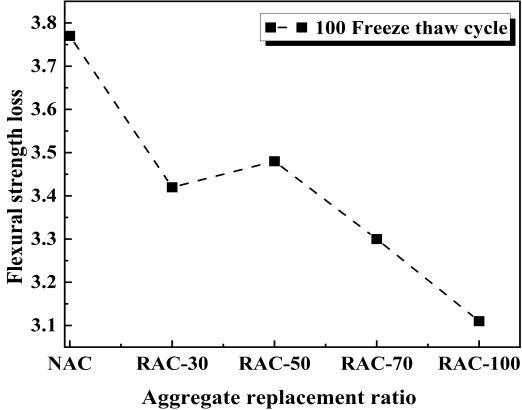
4.6
The process of the freezing and thawing cycle was analyzed based on the freezing and melting processes. In this study, analysis was conducted on the cycles of freezing and thawing at different phases. After analyzing the effects of the freezing and melting processes on a chosen random concrete specimen, the results are summarized. There are three stages during the freezing and thawing processes in the freeze-thaw cycle. in accordance with various temperatures: initial freezing and melting, phase transition, and deep freezing and melting. The first stage of the sample freezing process is the precooling stage, which is the drop from 20°C to the temperature of the water-ice phase transition stage (about 0°C). At this point, the temperature of the concrete sample is significantly different from the outside temperature.
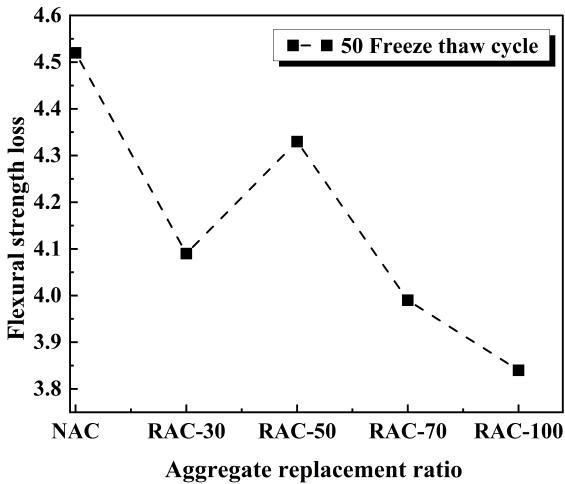

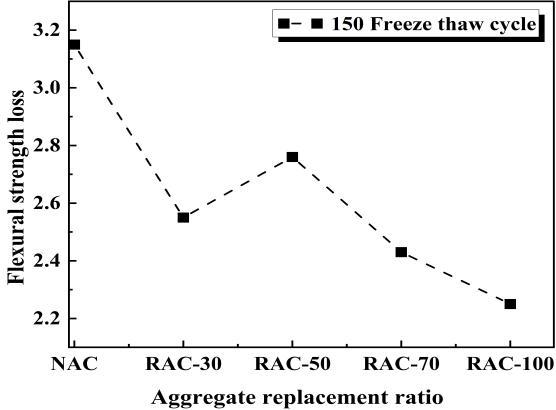

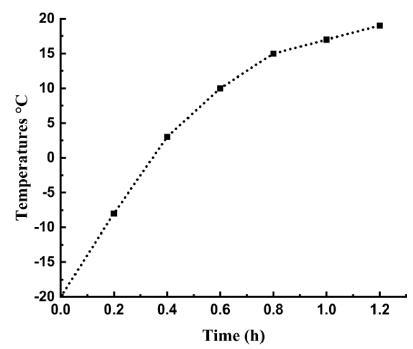
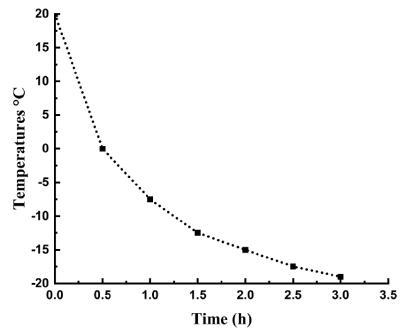
The rapid fluctuations in the concrete's internal temperature are caused by the stage's high convective heat transfer coefficient. Until the pore water starts to undergo water-ice phase transformation, there is no significant change in the in temperature. In the second phase, water and ice are in the process of changing from one another. At this stage, a significant amount of latent heat is released as the sample's pore water is gradually converted from water. The time it takes for the water to freeze over is relatively brief at this point. Despite this, the duration curve as a whole first goes up, and then it eventually stabilizes. This change in turn indirectly reflects an increase in the concrete's internal porosity, which ultimately results in an adequate phase transition process. As a consequence of this, the length of time slowly increases, and it demonstrates a shift of stabilization due to the consistent amount of water present. The cryogenic stage is the third and final stage. During the transition phase, the water in the pores freezes over time, but it does not reach a state of completely frozen. Consequently, during the cryogenic phase, the water in the pores is still passing through the process of transitioning from the water phase to the ice phase. There isn't much of a temperature difference between inside and out. Due to the low heat, the rate of change in temperature is also slowly reduces. The internal temperature drops to −20°C.
The process of melting the sample begins with this phase known as the preheating stage. This stage is the initial stage of the melting process. At this stage, the temperature might fluctuate anywhere between 20°C to the point where the porous ice within the concrete specimen begins to freeze. Moreover, there is a significant disparity in between the temperature of the specimens and the temperature of the surrounding environment. Because of the coefficient of convective heat transfer is fairly high, the rate at which the temperature is changing is quite quick. In spite of this, an ice-water phase change will eventually take place in the pores of the pore ice, which will result in a significant amount of heat absorption and a slower rate of overall temperature change. The ice-water phase transition phase represents the second stage of the process. The amount of time spent in this phase slowly extends with the number of cycles. On the other hand, the total time spent in this phase is significantly less than that spent in the water-ice phase transition phase when the water is freezing. This is due to the fact that ice possesses a thermal conductivity that is four times higher than that of water, which is the cause of the phenomenon. As a result, the amount of time spent in this stage is significantly less than the amount of time spent in the water-ice phase transition phase in the state of frozen. The third stage is called the deep heat stage, and it begins after the ice-water phase transition stage and continues until it reaches the desired temperature. The fundamental principle behind the cryogenic phase of the freezing process isthesameasthisphase.Thetiming diagramofthe freezing and melting processes in the concrete specimen is shown in Fig. 10.
(A)
(B) Melting process
4.7. Damage mechanism of freeze-thaw cycles on RAC.
Several research has been carried out in order to investigate the process of deterioration and the effect factors of freezethaw resistance on recycled concrete. Among them few mechanisms has been suggested to interpret the phenomenon of freeze-thaw deterioration. However, no agreement has been established to produce a thorough explanation of this issue. Some researchers believed that the hydraulic pressure caused by liquid flow may be the cause of freeze-thaw degradation. While others thought the freeze-thaw degradation can be explained by osmotic pressure. In this work, the scaling, deterioration, and aggregation of microcracks in the concrete were used to analyzed the damage mechanism of the RAC specimen before and after the freeze-thaw cycle.
Itisclearthatthereareseveralsignificantchangeshappened as the number of cycles of freezing and thawing increased, such as an increase in the number of pores, expansion of microcracks, and scaling of concrete. The occurrence of the phenomena is evidence that freeze-thaw cycles have a substantial impact on concrete, which increases the risk of concrete deterioration. Fig. 11. displays observations of concrete deformation for RAC slices. Cracks caused by frost heave steadily grew wider and longer when the repeated cycles of cycles of freeze-thaw increased. (Fig. 11(a) moisture migration and volume expansion, have the potential to cause damage to the internal structure of concrete that has been subjected to repeated cycles of freezing and thawing. Moreover, when the frost pressure surpasses the concrete's tensile strength, micro and macro cracks begin to develop, which eventually causes damage to the concrete. The number of micropores increases after several freeze-thaw cycles, which causes an increase in enlargement and the split of the ITZ by hydraulic and osmotic pressures, are displayed in Fig. 11. As a result of the repeated cycles of freeze-thaw, the RACs specimens' surfaces were broken. This indicate that the linkage of ITZs between the old mortars and the RA are very weaker.
(d)), and the degree of freeze thaw damage (scaling andspalling)slowlydecreased fromtheoutsidetotheinside (Fig. 11(c) and (d)). The severity of concrete damage after several cycles of freeze-thawwas ranked as follows: D >C>
B> A. This is evidence that the freezing and thawing cycle has a significant impact. Thus, the freeze-thaw cycle can reduce the anti-freeze performance of RAC.
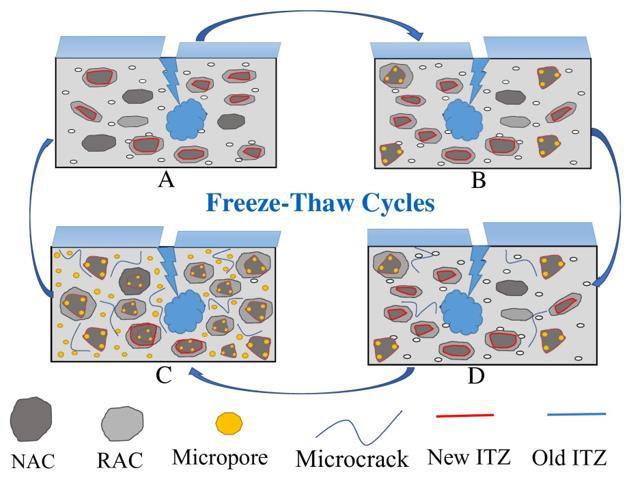
According to T.C. Powers, proposed mechanisms [47]. Hydraulic and frost-heaving pressures, which are caused by
In conclusion, when compared to concrete made with natural aggregates concrete made with recycled aggregate is more susceptible to freezing and thawing cycles. Natural aggregate concrete is less likely to crack or break. Consequently,when constructingpavementincoldclimates with recycled aggregate concrete, special consideration must be given due tothehighrisk of RAC causing structural damage to the pavement. To reduce this significant loss and to construct a high-quality road suitable for various weather conditions. This issue needs a further thorough and systematic study in order to guarantee the engineering quality of the pavement in cold areas
V. CONCLUSIONS
This study reveals the results of a laboratory investigations that ware carried out to illustrate the effect of freeze-thaw cycles on the RCA for construction of concrete pavement.
The investigated mixtures were proportioned with 0, 30, 50, 70, and 100% coarse RCA. The performance and deterioration of the cast recycled concrete specimens were assessed by evaluating their mass loss, relative dynamic modulus of elasticity (RDME), length change, flexural and compressive strength after numerous freeze-thaw cycles. Based on the results obtained in this study, the following conclusions are warranted:
1. Freezing and thawing can significantly impact the performance of the recycled concrete pavement. The alteration is usually observed in mass loss, relative dynamic modulus of elasticity (RDME), length change, flexural and compressive strength.
2. Recycled coarse aggregates have a detrimental impact on the specimens' ability to withstand freeze-thaw damage. After being subjected to 100 freeze-thaw cycles, edge-spalling was clearly observed in RAC-30 and RAC-50 specimens However, only a small fraction of mortar was scaled among the NAC specimens. Besides, RAC-70 and RAC-100 specimens experienced more severe damage due to greater aggregate mass loss. The results revealed that the deformation of the specimens accelerated as fast as the number of RAC replacement rose.
3. The cycle of freezing and thawing could be to reduce mass loss, relative dynamic modulus of elasticity (RDME), and length change. However, reduction rate depends on the incorporation of recycled aggregates. Thus, the reduction rate in RAC was much faster than in NAC. This is primarily because RAC has more pores and the attached old mortar on its surface, which becomes a weak link to the accumulation of freezethaw damage.
4. In general, every freeze-thaw cycle causes recycled concrete's flexural strength to rise and decline. For example, the flexural strength value changed by 4.09, 4.33, and 3.99 during 50 freeze-thaw cycles. This fluctuation happened because of improper recycled aggregate replacement towards the optimal value. In comparison to those others recycled concrete samples exposed to freeze-thaw cycles RAC-50% had minimum amount of flexural strength reduction and maximum flexural strength. For this test, the replacement rate's "optimal value" was RAC-50%. The flexural strength of concrete was lowest when recycled coarse aggregate was replaced at a rate of 70100% foreveryfreeze-thawcycle. The resultindicates that the replacement of RAC not only affects the mechanical properties of the specimens but also gets significantly affects the durability of the specimens to withstand the cold climate.
5. Initial freezing, water-ice phase change, and deep freezing are the three stages of the freezing process. With more freeze-thaw cycles, each process takes longer to complete. When there are more freeze-thaw cycles, the appearances of microcrack’s also started to appears followed by degradation and scaling of the specimens Microcrack
References
[1] S. C.Kou,C.S.Poon, andF.Agrela, “Comparisonsofnatural and recycled aggregate concretes prepared with the addition of different mineral admixtures,” Cem. Concr. Compos.,vol. 33, no. 8, pp. 788–795, 2011, doi: 10.1016/j.cemconcomp.2011.05.009.
[2] I. T. Systems, “ICCTP 2010: Integrated Transportation Systems Green•Intelligent•Reliable © 2010 ASCE 2515,” pp.2515–2521,2010.
[3] J. O. Bestgen, M. Hatipoglu, B. Cetin, and A. H. Aydilek, “Mechanical and Environmental Suitability of Recycled Concrete Aggregate as a Highway Base Material,” J. Mater. Civ. Eng., vol. 28, no. 9, pp. 1–13, 2016, doi: 10.1061/(asce)mt.1943-5533.0001564.
[4] F. D. C. Leite, R. D. S. Motta, K. L. Vasconcelos, and L. Bernucci, “Laboratory evaluation of recycled construction and demolition waste for pavements,” Constr. Build. Mater., vol. 25, no. 6, pp. 2972–2979, 2011, doi: 10.1016/j.conbuildmat.2010.11.105.
[5] Y. D. Wong, D. D. Sun, and D. Lai, “Value-addedutilisation ofrecycledconcreteinhot-mix asphalt,” Waste Manag.,vol. 27, no. 2, pp. 294–301, 2007, doi: 10.1016/j.wasman.2006.02.001.
[6] Z. Y.Pan et al., “Modified recycled concrete aggregates for asphalt mixture using microbial calcite precipitation,” RSC Adv., vol. 5, no. 44, pp. 34854–34863, 2015, doi: 10.1039/c5ra04203h.
[7] C.M.Nwakaire,S.P.Yap,C.W.Yuen,C.C.Onn,S.Koting, and A. M. Babalghaith, “Laboratory study on recycled concrete aggregate based asphalt mixtures for sustainable flexible pavement surfacing,” J. Clean. Prod., vol. 262, p. 121462,2020,doi:10.1016/j.jclepro.2020.121462.
[8] M. O. J. W. Ade, “PerformanceofRigid Pavements,” Transp. Res. Rec.,no.971071.
[9] Cement Concrete & Aggregates Australia, “Use of Recycled Aggregatesin Construction,” no. May, p. 25, 2008.
[10] A. S. Brand, A. N. Amirkhanian, and J. R. Roesler, “Flexural Capacity of Rigid Pavement Concrete Slabs With Recycled Aggregates,” no. 13, p. 108, 2013.
[11] “T. C. Power, ‘The Physical Structure and Engineering Properties of Concrete,’ Portland Cement Association, vol. Bulletin 90, 1958.”.
[12] J. Melorose, R. Perroy, and S. Careas, “Microstructure, Properties, and Materials,” Statew. Agric. L. Use Baseline 2015,vol.1,p.684,2015.
[13] C. Karakurt, “Freeze-Thaw Resistance of Normal and High Strength Concretes Produced with Fly Ash and Silica Fume,” vol.2015,2015.
[14] S. B. Huda and M. Shahria Alam, “Mechanical and FreezeThawDurabilityPropertiesofRecycledAggregateConcrete MadewithRecycledCoarseAggregate,” J. Mater. Civ. Eng., vol. 27, no. 10, p. 04015003, 2015, doi: 10.1061/(asce)mt.1943-5533.0001237.
[15] H. Wu, Z. Liu, B. Sun, and J. Yin, “Experimental investigation on freeze-thaw durability of Portland cement pervious concrete (PCPC),” Constr. Build. Mater.,vol. 117, pp.63–71,2016,doi:10.1016/j.conbuildmat.2016.04.130. http://www.fhwa.dot.gov/publications/research/infrastructur e/structures/97148/nfs1.cfm
[16] P.Jia et al., “Performance Evolution of Recycled Aggregate Concrete under the Coupled Effect of Freeze–Thaw Cycles and Sulfate Attack,” Appl. Sci., vol. 12, no. 14, 2022, doi: 10.3390/app12146950.
[17] C. S. Rangel, M. Amario,M. Pepe, E. Martinelli, and R. D. T. Filho, “Durabilityofstructuralrecycled aggregateconcrete subjectedtofreeze-thaw cycles,” Sustain.,vol.12,no.16,pp. 1–21,2020,doi:10.3390/su12166475.
[18] D. Zou, Z. Wang, M. Shen, T. Liu, and A. Zhou, “Improvement in freeze-thaw durability of recycled aggregate permeable concrete with silane modification,” Constr. Build. Mater., vol. 268, p. 121097, 2021, doi: 10.1016/j.conbuildmat.2020.121097.
[29] “GB/T 25177, Recycled Coarse Aggregate for Concrete, Ministry of Housing and Urban–Rural Development of the People’s Republic of China. Beijing, China, 2010.”.
[30] “JCJ53, Technical Requirements and Test Method of Gravel and Crushed Stone for Ordinary Concrete, Ministry of Housing and Urban–Rural Development of the People’s Republic of China, Beijing China, 1994.”.
[31] “EN933-4, Tests for Geometrical Properties of Aggregates, Part 4: Determination of Particle Shape-Shape index, European Committee for Standardization, 2008.”.
[32] ASTM C192/C192M, “Standard Practice for Making and Curing ConcreteTestSpecimensin theLaboratory,” Am. Soc. Test. Mater.,vol.04,pp.1–8,2016.
[33] C. C. Test and B. Statements, “Standard Test Method for Slump of Hydraulic-Cement Concrete 1,” pp. 1–4, doi: 10.1520/C0143.
450,2019,doi:10.1016/j.conbuildmat.2019.03.203.
[19] P. Zhu, Y. Hao, H.Liu, D. Wei, S.Liu, and L. Gu, “Durability evaluationofthreegenerationsof100%repeatedlyrecycled coarse aggregate concrete,” Constr. Build. Mater., vol. 210, pp.442
[20] A. Richardson, K. Coventry, and J. Bacon, “Freeze/thaw durability of concrete with recycled demolition aggregate compared to virgin aggregate concrete,” J. Clean. Prod.,vol. 19, no. 2–3, pp. 272–277, 2011, doi: 10.1016/j.jclepro.2010.09.014.
[21] P. Zhu, Y. Hao, H. Liu, X. Wang, and L. Gu, “Durability evaluation of recycled aggregate concrete in a complex environment,” J. Clean. Prod.,vol.273,p.122569,2020,doi: 10.1016/j.jclepro.2020.122569.
[22] A. Abbas, G. Fathifazl, O. B. Isgor, A. G. Razaqpur, B. Fournier, and S. Foo, “Durability of recycled aggregate concrete designed with equivalent mortar volume method,” Cem. Concr. Compos.,vol.31,no.8,pp.555–563,2009,doi: 10.1016/j.cemconcomp.2009.02.012.
[23] A. Gokce, S. Nagataki, T. Saeki, and M. Hisada, “Identification of frost-susceptible recycled concrete aggregates for durability of concrete,” Constr. Build. Mater., vol. 25, no. 5, pp. 2426–2431, 2011, doi: 10.1016/j.conbuildmat.2010.11.054.
[24] H. Wen, D. I. McLean, and K. Willoughby, “Evaluation of recycled concrete as aggregates in new concrete pavements,” Transp. Res. Rec.,vol.2508,no.SourceC,pp.73–78,2015, doi:10.3141/2508-09.
[25] S. Sadati and K. H. Khayat, “Field performance of concrete pavement incorporating recycledconcrete aggregate,” Constr. Build. Mater., vol. 126, pp. 691–700, 2016, doi: 10.1016/j.conbuildmat.2016.09.087.
[26] O. Bozyurt, A. K. Keene, J. M. Tinjum, T. B. Edil, and D. Fratta, “Freeze-thaweffectsonstiffnessofunboundrecycled road base,” ASTM Spec. Tech. Publ., vol. 1568 STP, no. December 2015, pp. 3–21, 2013, doi: 10.1520/STP156820130014.
[27]J.Xiao, Erratum to: Recycled Aggregate Concrete Structures 2018.doi:10.1007/978-3-662-53987-3_16.
[28] U.S. Department of Transportation Federal Highway Administration, User Guidelines for Waste and Byproduct Materials in Pavement Construction, vol. 152697. 2016. [Online]. Available:
[34] AstmC666/C666M,“StandardTest Method forResistanceof Concrete to Rapid Freezing and Thawing,” ASTM Int. West Conshohocken, PA,vol.03,no.Reapproved,pp.1–6,2003.
[35] ASTM, “ASTMC 78: Standard Test Method for Flexural Strength of Concrete (Using Simple Beam with Third-Point Loading)ASTM International. USA,” Annu. B. ASTM Standars,vol.04.02,pp.1–3,2002
[36] Y. Huang, X. He, H. Sun, Y. Sun, and Q. Wang, “Effects of coral, recycled and natural coarse aggregates on the mechanicalpropertiesofconcrete,” Constr. Build. Mater.,vol. 192, pp. 330–347, 2018, doi: 10.1016/j.conbuildmat.2018.10.111.
[37] Y.Haitao and T. Shizhu, “Preparation and properties of highstrength recycled concrete in cold areas,” vol. 65, no. 318, pp. 1–6,2015.
[38] M.Tuyan,A.Mardani-Aghabaglou, andK. Ramyar,“Freezethaw resistance, mechanical and transportpropertiesofselfconsolidating concrete incorporating coarse recycled concrete aggregate,” Mater. Des.,vol.53,pp.983–991,2014, doi:10.1016/j.matdes.2013.07.100.
[39] A. Domingo-Cabo, C. Lázaro, F. López-Gayarre, M. A. Serrano-López,P.Serna,andJ.O.Castaño-Tabares, “Creep and shrinkage of recycled aggregate concrete,” Constr. Build. Mater., vol. 23, no. 7, pp. 2545–2553, 2009, doi: 10.1016/j.conbuildmat.2009.02.018.
[40] A. Reprint, “A Working Hypothesis for Further Studies of Frost Resistance of Concrete,” ACI J. Proc., vol. 41, no. 1, 1945,doi:10.14359/8684.
[41] T. C. Powers and R. A. Helmuth, “Theory of volume changes in hardened portland-cement paste during freezing,” Am. Concr. Institute, ACI Spec. Publ.,vol.SP-249,pp.141–159, 2008.
[42] J.Wu,X.Jing,and Z. Wang, “Uni-axialcompressivestressstrain relation of recycled coarse aggregate concrete after freezing and thawing cycles,” Constr. Build. Mater.,vol.134, pp.210–219,2017,doi:10.1016/j.conbuildmat.2016.12.142.
[43] X. Deng et al., “Investigation of microstructural damage in air-entrained recycled concrete under a freeze–thaw environment,” Constr. Build. Mater., vol. 268, p. 121219, 2021,doi:10.1016/j.conbuildmat.2020.121219.

